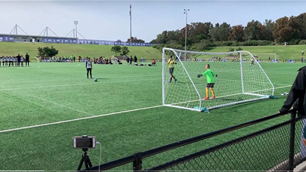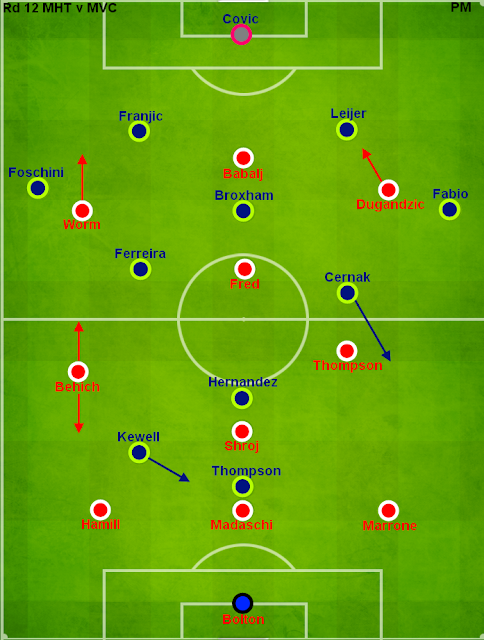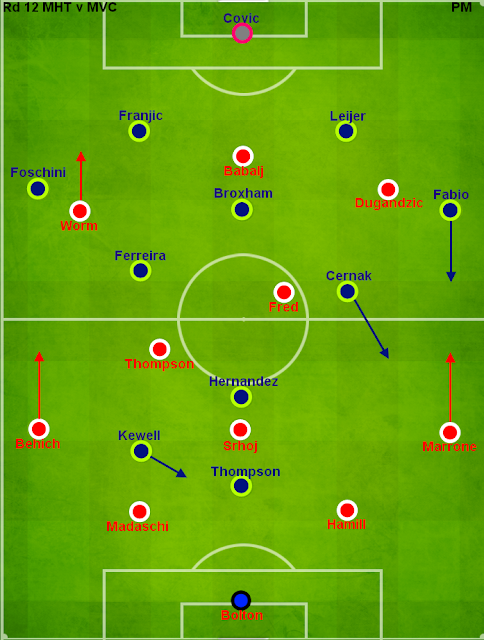Analysis of Heart's 3-2 triumph over Victory in last week's thrilling Melbourne Derby
This edition of the Melbourne Derby was a thrilling contest, fought between two clubs with contrasting approaches. Heart were able to emerge victorious, largely due to the shrewdness of Dutch manager John van't Schip. Having seen his initial theoretically sound tactical plan fail to contain the sparkling Victory trident of Hernandez, Kewell and Thompson, the former Ajax winger changed Heart's formation, and from then were in the ascendant. This match superbly illustrated the superiority of a collective 'system' over reliance on individual 'star power' in building a team.
Victory's System:
Durakovic deployed Victory largely as expected, in a 4-3-1-2, with a few interesting tweaks. Covic continued as custodian, Franjic and Leijer were paired in central defence, with Fabio and Foschini at left and right fullback. Broxham, Ferreira and Cernak formed a midfield trio, with the latter two given more licence to join the attacker, and the former assigned the holding role, screening the back-four. Hernandez was fielded in his usual trequartista role, Kewell drifted to the right as the seconda punta, with Thompson leading the line as the central striker.
Heart's System:
Van't Schip radically altered Heart's formation, from the usual 4-3-3 to a 3-4-3 diamond. Bolton was in goal, while Hamill, Madaschi and Marrone constituted the three-man defence. Shroj fulfilled the holding role in midfield, versatile central midfielder Thompson was fielded as the right carillero (side midfielder in a diamond), while aggressive winger turned fullback Behich was deployed as the left carillero, with Fred as a deeper-lying creator, at the tip. Silky target-man Babalj led the line, with Worm and Dugandzic at left and right wing.
Three Wise Men:
Van't Schip sprung a minor selection surprise with his staring XI. Reverting to a three-man defence was a near certainty, as it would theoretically work perfectly against Victory's strike partnership. But unlike the other occasions when Heart have utilised a three-man backline, van't Schip did not introduce an extra nominal centre back. Instead, he opted to shift technical fullback Marrone to the right-sided centre back position.
Balance unbalanced:
The major unknown was whether van't Schip would favour a 3-3-1-3 with wingbacks, which might have left Fred isolated and out-muscled in central midfield, or a 3-4-3 diamond, matching the Navy Blues man-for-man in central midfield, but leave defensive responsibilities for the Victory fullbacks Fabio and Foschini almost entirely to the Heart wingers Worm and Dugandzic.
In the end, Van't Schip settled for a compromise between the two. He fielded Behich, a winger converted to fullback, on the left of his midfield diamond, and Thompson, a versatile central midfielder, on the right.
With a wingback on the left, adept at stretching the play wide, van't Schip was comfortable fielding nominal centre back Hamill on the left of the three-man defence. Conversely, with a central midfielder on the right of midfield, van't Schip had nominal fullback Marrone on the right of the three-man defence, to provide width by spreading play to the flanks.
As noted before, one of the factors influential on van't Schip's previous decisions to use three-man defences was the unavailability of certain players - against Adelaide, Fred was injured, and against Central Coast, Behich was unavailable. So those two line-ups featured three centre backs in the defence. On this occasion, van't Schip more or less had a full deck to choose from, and the decision to field Marrone in defence was a symptom of Heart wanting to squeeze in as many of their 'big guns' into the XI as possible.
Unnatural width:
One of the interesting tactical features of Victory in recent weeks has been Durakovic's adoption of a 4-3-2-1 Christmas tree shape. Before this match, Victory captain Adrian Leijer highlighted the contrasting approaches adopted by his own team, and their bitter rivals, which he eloquently summarised as "they've got the good football, we've got the star names".
Victory have indeed pursued something of a Galacticos policy this term, and Durakovic spent the first few weeks of this season trying to figure out how to crowbar strikers Allsopp and Thompson, playmakers Hernandez and Kewell, and electric winger Rojas into the same team, not to mention find enough room on the pine for another striker and winger in the form of Solorzano and Cernak.
But utilising up to five forwards, none of whom were particularly defensively disciplined, left the team amazingly vulnerable on the counter-attack. If one of the fullbacks was caught up-field, Victory would only be able to defend with four players; the two centre backs, the opposite fullback, and a single holder.
To obfuscate this vulnerability, Durakovic has adopted a more conservative tactical outlook. Essentially, he has switched from a single holder and five forward to three holders and three forwards. This affords the Navy Blues a more robust presence in central midfield, and a defensive platform which absolves the forward trio from defensive duties.
The problem with the 4-3-2-1 formation however, is a lack of natural width, especially in the attacking third. In fact, the point of using such a formation is to exchange wingers for extra midfield security. This lack of width is exacerbated by the fact that neither of Victory's preferred fullbacks are accomplished attackers. To compensate for this, Durakovic has regularly deployed a nominal winger into one of the midfield berths; in this occasion, Isaka Cernak shuttled between a central midfield role when Victory were out of possession, and a left wing role when Victory were attacking, effectively operating as a inverted winger.
Similarly, Harry Kewell and Archie Thompson were tasked to alternate stretching the play to the right flank, by taking up positions on the wing. The combination of these two factors meant that Victory often resembled a 4-2-3-1 when in possession, and this allowed the Navy Blues to play with a semblance of width, while still retaining the necessary midfield platform to compensate for the lack of defensive work from the forward trio.
A corollary to this point was the fact that Kewell and Cernak, wingers deployed 'out of position', were also deployed on their non-preferred sides. Cernak is right-sided, while Kewell made his name as a left-winger, but in this match, the former was deployed on the left, and the latter on the right. This was probably a concession to a lack of a target-man on the pitch; inverting the two 'wingers' allows them to cut inside and attack the goal, instead of crossing the ball when Victory lacked a clear aerial advantage.
Back to the drawing board:
The tactical plan van't Schip formulated was theoretically flawless - the three man backline accounted for Victory's strike partnership, the lopsided midfield diamond matched the Blues man-for-man and the Heart forward trio would be tasked with dismantling a back-four. Yet it was the Navy Blues who started the match the brighter, overwhelming the Heart defence, even opening the scoring on the 20th minute mark. Why did van't Schip's 3-4-3 fail?
There were two main reasons. Firstly, Victory started the match pressing very aggressively. Heart are a team that are committed to building attacks from the back and keeping possession, but their less familiar three-man backline was having difficulty dealing with the ferocity of Victory's pressing. Various players were exhibiting signs of positional confusion; in fact Archie Thompson's goal was a prime example of this. Covic's goal-kick bounced fortuitously behind Madaschi, who had stepped up to contest Kewell in the air. Thompson ghosted around Hamill, who had probably forgotten Behich was not nearby at left back to cover, but instead at left midfield. Thompson's finish was superb, but Heart's defence was clearly struggling to adjust to the new positions.
Secondly, Victory were attacking with more width than Heart had initially accounted for, with their narrow three-man backline. Theoretically, the three-man defence works perfectly against two strikers; two centre backs man-mark with the third covering as a sweeper. As explained above however, Kewell and Thompson were very intelligent in their movement. Instead of staying in central positions, allowing themselves to be marked out of the game by the three Heart centre backs, both took it in turns to occupy the vacant space to the left of Hamill, effectively operating as auxiliary right wingers. Cernak too was instrumental in dragging the Heart defence out of shape. He occupied positions very high up the left flank, dragging Marrone out of the defence. This created huge gaps in the Heart backline; Hamill and Marrone were dragged to the fullback positions, while Madaschi was literally trying to do the work of two centre backs, attempting to cover a huge amount of space in front of the 18-yard box. Hernandez and Ferreira were very intelligent in exploiting this space, making runs to burst through the Heart defence.
A three-man defence works best against two strikers, but when in possession, Victory were effectively using a forward trio; Kewell on the right wing, Thompson through the middle, and Cernak on the left. As explained previously, when a back-three comes up against a forward three, problems tend to arise. In this case, the two centre backs were dragged wide, and the defence became too stretched.
Width for numbers:
Around the 20th minute mark, after going a goal down to the visitors, van't Schip decided to act. His 3-4-3 was originally formulated in anticipation of facing a narrow 4-3-2-1, but Heart were becoming stretched because of the wide movement of Cernak and Kewell. Heart needed to re-assert control of the wide areas in their own defensive half.
To accomplish this, van't Schip reverted to the usual 4-3-3 formation, featuring two fullbacks in the defence. Behich retreated to left fullback, Madaschi and Hamill shuffled across to form the centre back pairing, and Marrone shifted back to right fullback. Thompson switched back to left central midfield, while the rest of Heart's players stayed the same.
With two fullbacks covering the flanks, and with four players covering the width of the defence instead of just three, Heart re-established dominance of the wide areas. The vacant space Kewell and Cernak had previously exploited was now occupied by Behich and Marrone. Essentially van't Schip discarded his spare man in central defence; Kewell and Thompson were now up against only Madaschi and Hamill, in order to gain more width, with the caveat that the two fullbacks would take it in turns to tuck inside and provide cover.
Although arguably Rose, Franjic and Cassio are better individual talents, Heart are able to call upon the best pair of fullbacks in the league. With no direct opponents looking to check their advances, as Kewell and Cernak were instructed to fold back into the centre when out of possession, Marrone and Behich simply ran riot. After Heart had settled down and begun to dictate play, both advanced far into midfield to provide width to support the attack. This worked better on the right flank, as far too often Rutger Worm decided to stay wide instead of cutting inside to create space for Behich to overlap.
Around this time Victory ceased their high press and began to stand off, allowing Heart time on the ball. The tables had turned; Victory were superior in the opening stages because, counter-intuitively, the Blues had more width in their attacking third that the Red and Whites had in their defensive third, and their intense pressing unsettled an unfamiliar backline. Heart were able to seize control of the match, by re-establishing control of the wide areas, and by monopolising possession.
Your move sir:
Van't Schip's tactical shift from a three to a four-man backline left Durakovic in an unenviable position. His measures for makeshift width - Cernak shuttling to the left and Kewell drifting right - were no match for permanent width in Heart's two fullbacks. In addition, his charges did not possess enough energy to sustain an intense press that had so effectively shackled the opposition's build-up play.
Durakovic was essentially stuck between a rock and a hard place; he could persist with the narrow 4-3-2-1 and be bypassed on the flanks, trusting to mass of numbers in the middle to provide defensive sturdiness, or switch to a wider 4-2-3-1, with Cernak and Kewell permanently on the wings in order to pin-back Behich and Marrone, and be outnumbered and out-passed in midfield, with Fred, Shroj and Thompson up against the none-too creative double pivot of Ferreira and Broxham. Durakovic went with the former option, and it's hard to fault his decision. Traditionally, Victory have prospered with a defensive/counter-attacking approach, and opening up the midfield would have benefited Heart more than it might have harmed their influence out wide.
Matt Thompson's elegant double, orchestrated largely by former Victory man Fred, pretty much decided the contest. Victory persisted with their course, but never looked like opening up a more resilient Heart defence.
True or false:
Although little more than a post-script, Alex Terra was substituted on for Eli Babalj with around half an hour remaining on the clock. Babalj, by virtue of being a target-man, provides a focal point to the Heart forward line, allowing them to adopt a more direct style. But the trade-off is that Heart's attack can become too predictable and boxy, with little interchange between players.
Alex Terra however, is a completely different player. Able to operate as a trequartista or winger, when fielded as the most advanced forward, Terra becomes a False Nine, vacating his central position to create space and drag the opposition defence apart. His goal was well taken, but his more notable contribution in a tactical sense was his movement in open play. His first action on the pitch, was to drift high to the right flank, allowing Dugandzic to cut inside towards goal.
This links back to the point made previously, of the tactical variety that van't Schip's has assiduously cultivated. Heart have demonstrated a remarkable ability to alter not just their formations, from three to four man backlines, but also their styles, from more patiently possession oriented with a False Nine in Alex Terra, but also a more direct style through the hold-up play of Eli Babalj.
Conclusion:
A fascinating tactical contest between the two Melbourne clubs was won by the better team. Van't Schip's initial plan was foiled by Durakovic's gambits for auxiliary width, but ultimately, Victory were unable to deal with Heart's changes. Credit to Durakovic for a plan that successfully upset the superior team, but in the end, Victory's approach is all about getting the best out of individual talent - the midfield platform absolving Hernandez, Kewell and Thompson from defensive duties is particularly illustrative. Van't Schip has built a cohesive team with a dedication to a purist philosophy. For the immediate future at least, Melbourne is red and white.
Player Rankings:
Heart | Victory
10) Worm | Franjic
9) Dugandzic | Leijer
8) Shroj | Thompson
7) Hamill | Fabio
6) Babalj | Broxham
5) Madaschi | Foschini
4) Behich | Ferreira
3) Marrone | Kewell
2) Thompson | Cernak
1) Fred | Hernandez
I would like to thank all of you who have left generous messages and comments on FourFourTwo, PM and over Twitter. Your support and encouragement is much appreciated.
Related Articles

Fresh talent flock to ambitious A-League outfit's pro pathway

Why A-League 20/21 is crucial for Olyroos’ medal hopes


















